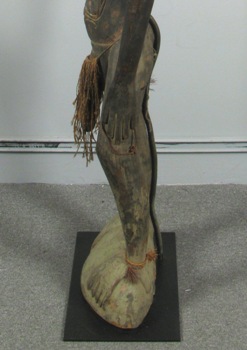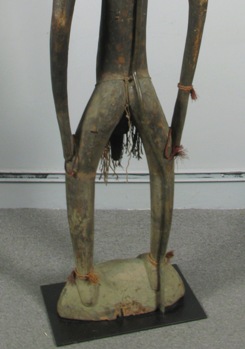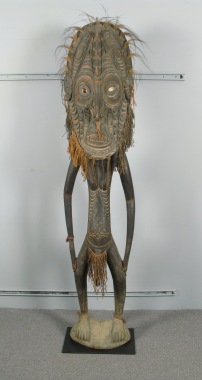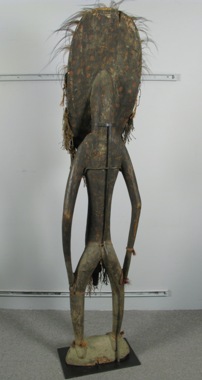By Gabrielle Tieu, Associate Conservator of Objects,
Tina Gessler, Associate Conservator of Objects,
and Josh McCauley, Associate Conservator of Frames and Gilded Objects
(Above) Example of a custom mount
As historic objects age, natural degradation processes may weaken what were once strong supports and stable points of attachments. As this happens, the necessity of a proper mount increases. Whether the purpose is stabilization, prevention, or display, mounts are an often overlooked yet important part of the conservation process, and warrant consideration as a preventative approach to long-term preservation.
Damage to objects is often time related to either poorly constructed mounts or the lack of a mount altogether. It is important to understand that every piece is unique and should be treated accordingly. From a conservation perspective there are several variables, both physical and aesthetic, which factor into establishing a suitable mount structure: fragility, height, weight, appearance, and most importantly, the fit to a piece.
Each mount should fit snugly to the piece to provide adequate support; however, not too tight to avoid unnecessary pressure. A mount should be constructed of material appropriate to the piece (i.e., stainless steel for heavier objects, brass or Plexiglas for lighter pieces, and specially created pillows for books and other delicate objects) with archival padding material to buffer the object from the mount preventing scratches and abrasions. Below are a couple examples illustrating the importance of proper mounting.
The mount for the figurative resin sculpture shown below proved to be a complex challenge. It was obvious the artist intended to have the object appear as if it were floating or being supported by something invisible. Originally, the piece was supported by a single steel rod embedded in the proper left foot and attached to a wood base, while the right foot floated slightly above the base. This was particularly problematic because the legs are hollow and the top is much denser and extremely heavy, and the original mount did not provide an adequate center of gravity. Consequently, when the sculpture was handled improperly or bumped the piece fell over and cracked at the thigh level of the supporting leg.
Upon examination, it was obvious there had been a history of damage near the same level, and evidence of previous repairs. Our major concern was to create a custom mount providing overall support and prevent the same break from reoccurring in the future. Other concerns included preventing any pressure on the numerous stress cracks throughout the sculpture and evening out the weight distribution, while minimizing visual obstructions.
(Above) Pre-treatment: Resin sculpture broken at the thigh level
(Above) Detail: Close-up of break
After the leg was firmly reattached, focus turned to the construction of a mount suitable to support the overall weight and the newly repaired area. The mount had to change the primary area of support from the single embedded rod through the foot to a central location, while respecting the artist’s intention to keep the mount as invisible as possible so as to not disrupt the viewer’s perception. It was determined that the best option was to create a contoured cradle to fit underneath the saddle, allowing the weight of the sculpture to be supported safely and evenly. A single steel rod was designed to cradle the proper left foot, run up the length of leg, and contour underneath the saddle. The pre-existing embedded rod was then used to connect the sculpture to the original wood base. The new mount was toned to emulate the sculpture’s existing finish.
(Above) Detail: Mount cradling foot and leg
(Above) Detail: Contoured rod under saddle
(Above) Detail: Post treatment
Another example, a Pacific Island carved-wood figure, was damaged because it lacked an appropriate mount. Due to disproportionate elements, the oversized head had broken off at the base of the neck line. Treatment for the piece presented a major problem, as the neck diameter was comparably small, and the only point of connection. It was decided that a mount was necessary in order to reconnect the head and body. Therefore, a mount was created before the actual treatment process began to aid in support and proper alignment of the separated pieces.
First, a metal base was created to fit the bottom of the piece to ensure an even, level and weighted foundation for the figure to remain stable. A steel rod was then contoured gently along the back of the piece and padded with self-adhesive polyester felt. The rod ran the length of the body with two brackets designed to cradle under each arm. A removable c-shaped clamp extended slightly above the break and around the neck to support the weight of the head. The body was then placed onto the mount with the brackets secured, and the c-clamp partially removed to access the damaged area. Using conservation adhesives, the head was positioned onto the body allowing gravity to seat it into place. The c-clamp was then secured to help support the head while the conservation adhesive cured. In this case the mount aided the conservation process and will provide long-term stability, through the support it provides, to the break and the counterweight built into the base.
(Above) Pre-treatment
(Above) Detail of break
(Above) Detail: Mount contoured to figure
(Above) Detail: C-Clamp supporting neck and head
(Above) Post-treatment
While both of the cited examples are near life-size, mounts are not exclusive to size, weight or composition. As objects age the materials from which they are constructed may weaken. With the assistance of additional and well thought out support, such as a mount, an object may be preserved and protected from unnecessary damage.














